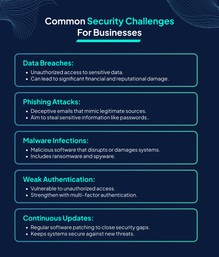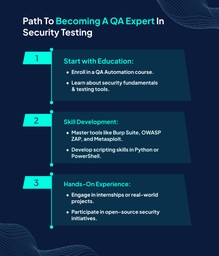Welcome to the quality assurance (QA) world and its vital role in keeping digital systems safe!
As more of our daily activities, like shopping and banking, move online, the urgency to ensure that our digital information stays secure is growing.
Did you know experts predict around 4 billion digital payments will be made annually by 2028?
That’s a lot of transactions happening in the digital world!
As more people do things online, we need better security software to protect our information.
But how does one become a QA expert in security testing?
Well, that’s where a QA Automation course comes into play.
Enrolling in a QA Automation course can pave the path toward a successful career in security testing.
This course provides hands-on training and practical skills in testing and securing digital systems with automation tools.
What is Security Testing?
Security testing is a type of software testing that aims to identify vulnerabilities, threats, and risks in a software application and ensure that the application’s data and resources are protected from potential intruders. The primary objective of security testing is to uncover potential weaknesses in the system’s security mechanisms that could be exploited to gain unauthorized access or cause other malicious activities.
Key components of security testing include:
- Vulnerability Scanning: Automated tools are used to scan the system for known vulnerabilities.
- Penetration Testing: Simulated cyber attacks are conducted to identify vulnerabilities that could be exploited by an attacker.
- Risk Assessment: Identifying potential security risks and evaluating their impact on the system.
- Security Auditing: Reviewing and examining the system’s security policies and procedures.
- Ethical Hacking: Ethical hackers attempt to break into the system to discover security weaknesses.
- Posture Assessment: Combining security scanning, ethical hacking, and risk assessments to provide an overall security posture of the system.
Security testing is essential in ensuring the integrity, confidentiality, and availability of data in software applications, making it a critical aspect of the software development lifecycle, particularly for applications that handle sensitive information.
The Common Security Issues Faced by Businesses
Let’s take a friendly stroll through some of the everyday security challenges that businesses often encounter:
- Data Breaches: Picture this—it’s like someone sneaking into your secret treasure chest of customer data and financial records. When unauthorized parties get their hands on this information, it’s not just a headache; it’s a full-blown disaster!
- Phishing Attacks: Ever received an email that seemed too good to be true? Phishing attacks are like those pesky tricksters trying to steal your identity by pretending to be your best friend. Watch out for those sneaky emails and dodgy websites!
- Malware Infections: Think of malware as the ultimate digital gremlin, wreaking havoc on your systems and holding your data hostage. Stay vigilant and keep your software up-to-date to fend off these nasty surprises.
- Weak Authentication: We all know the importance of a strong password, right? Weak authentication practices are like unlocking the front door—they invite trouble! It’s time to beef up those passwords and add a layer of protection with multi-factor authentication.
- Insider Threats: Imagine your trusted colleague accidentally clicking on the wrong link and unknowingly letting the bad guys in. It’s crucial to watch for suspicious behavior and ensure everyone is on board with cybersecurity best practices.
- Unpatched Software: Remember those annoying pop-ups reminding you to update your software? They’re pretty important! Keeping your software patched and up-to-date is like putting a lock on your digital windows—it keeps cybercriminals out.
- Insecure APIs are like bridges connecting different parts of your digital world. But if those bridges aren’t secure, it’s like rolling out the carpet for cyber attackers! Ensure your APIs are locked down tight to keep your data safe and sound.
- Lack of Security Awareness: Use security awareness as your secret weapon against cyber threats. When everyone in the team knows how to spot a phishing email or create a rock-solid password, it’s like having a superpower that protects your business from harm.
By tackling these challenges with a friendly but proactive approach – educating your team, keeping your systems updated, and staying vigilant against cyber threats – you can build a digital fortress that keeps your business safe and sound.
What Does QA Do in Security Testing?
Quality Assurance (QA) is like the gatekeeper of digital integrity. Its primary function is ensuring that software and digital systems meet the highest quality, functionality, and security standards.
Regarding security testing, QA is critical in identifying vulnerabilities and weaknesses in digital systems before malicious actors can exploit them.
Here’s a closer look at QA’s role in security testing:
Identifying Security Risks
QA professionals meticulously analyze digital systems to pinpoint potential security risks and vulnerabilities. They conduct thorough assessments to identify weak spots in the software’s architecture, coding practices, or implementation that attackers could exploit.
Implementing Security Measures
Once vulnerabilities are identified, QA works hand-in-hand with developers and security experts to implement robust security measures. This could involve patching security holes, strengthening encryption protocols, or implementing access controls to prevent unauthorized access.
Testing Security Controls
QA conducts rigorous testing of security controls to make sure they are effective in mitigating potential threats. This includes testing authentication mechanisms, encryption algorithms, and authorization protocols to verify their resilience against various attack vectors.
Compliance and Standards
QA ensures that digital systems adhere to industry standards and regulatory requirements related to security. This involves conducting audits and assessments to verify compliance with standards like GDPR, HIPAA, or PCI DSS, depending on the industry and geographical location.
Continuous Monitoring and Improvement
Security is an ongoing process, and QA plays a crucial role in continuously monitoring digital systems for new threats and vulnerabilities. They proactively update security measures, conduct regular security audits, and refine testing protocols to stay ahead of evolving cyber threats.
Examples of QA Role in Cyber Security
Let’s explore some real-life examples of how Quality Assurance (QA) professionals play a critical role in cybersecurity:
Vulnerability Assessment and Patch Management
Imagine a QA team working for an e-commerce company. During routine website testing, they discovered a vulnerability in the payment processing system that could allow hackers to steal customers’ credit card information.
The QA team promptly notifies and collaborates with the development team to prioritize and patch the vulnerability before malicious actors can exploit it. By identifying and addressing the vulnerability, the QA team helps prevent a potential data breach and protects the company’s reputation and customer trust.
Security Testing and Penetration Testing
Suppose a financial institution employs a QA team to assess the security of its online banking platform. As part of their security testing efforts, the QA team conducts a simulated phishing attack targeting employees to assess their awareness of social engineering tactics.
They also perform penetration testing on the banking platform to identify any weaknesses that cybercriminals could exploit. Through their testing efforts, the QA team helps the bank identify and remediate vulnerabilities, strengthening the security of its online services and protecting customers’ financial assets.
Code Review and Secure Coding Practices
Let’s say a software development company is preparing to launch a new mobile banking app. The QA team conducts a comprehensive code review of the app’s source code to identify any security flaws or vulnerabilities.
During the review, they discovered that the app is not correctly encrypting sensitive user data stored on the device, making it vulnerable to theft if lost or stolen. The QA team provides recommendations to the development team on implementing secure coding practices, such as encryption and data obfuscation, to mitigate the risk of unauthorized access to sensitive information.
Compliance and Regulatory Requirements
Consider a healthcare organization developing a new electronic health record (EHR) system. The QA team ensures the EHR system complies with regulations like the Health Insurance Portability and Accountability Act (HIPAA) to protect patients’ sensitive medical information.
They verify that the system incorporates appropriate security measures, like access controls and encryption, to safeguard patient data from unauthorized access or disclosure. By ensuring compliance with regulatory requirements, the QA team helps the healthcare organization avoid costly fines and legal liabilities associated with data breaches or non-compliance.
Incident Response and Disaster Recovery
Suppose a large technology company experiences a cyber attack that disrupts its operations and compromises customer data.
As part of the incident response team, the QA team is crucial in coordinating the company’s response efforts. They assist in analyzing the incident, identifying the root cause of the breach, and implementing remediation measures to contain the damage and prevent further exploitation.
Additionally, the QA team helps develop and test disaster recovery procedures to restore the company’s systems and services in the event of future cyber incidents, ensuring business continuity and resilience against cyber threats.
What Kind of Programming Languages are Used in Security Testing?
Let’s explore the programming languages commonly used in Quality Assurance security testing:
- Python: Python is a very versatile and widely used programming language in the field of cybersecurity and QA testing. Its simplicity, readability, and extensive libraries make it an excellent choice for automating security tests, scripting security tools, and developing custom testing frameworks.
Python is particularly well-suited for tasks such as web scraping, network scanning, and writing automated test scripts for security testing tools.
- JavaScript: JavaScript is another popular language used in QA security testing, especially for web application testing. It is commonly used to write test scripts for web-based security testing tools like Selenium and Puppeteer.
JavaScript frameworks like Node.js are also used for server-side scripting and building custom security testing tools or utilities.
- Shell Scripting: Shell scripting, using languages like Bash or PowerShell, is essential for automating system-level tasks and executing command-line tools in security testing.
Shell scripts are often used for tasks such as automated vulnerability scanning, log analysis, and system configuration management in both Linux and Windows environments.
- SQL: SQL (Structured Query Language) is indispensable for testing and securing databases in QA security testing.
QA teams must be proficient in writing SQL queries to perform database vulnerability assessments, data validation, and injection testing to uncover vulnerabilities like SQL injection or data leakage.
- Ruby: Ruby is commonly used in QA testing frameworks like Cucumber, which supports behavior-driven development (BDD) and allows testers to write test scenarios in plain English.
Ruby is also used in security test management tools like Metasploit, a popular framework for penetration testing and exploiting security vulnerabilities.
- Java: Java is widely used in enterprise environments and is often preferred for developing robust, scalable, and maintainable security testing frameworks.
Many security testing tools and libraries, such as OWASP ZAP and JUnit, are written in Java. Java’s strong object-oriented programming features make it suitable for building complex security testing solutions and integrating with other enterprise systems.
- C/C++: While less common in QA security testing compared to other languages, C and C++ are still used in certain contexts, particularly for low-level security testing, kernel-level programming, or developing security-critical applications.
Tools like Wireshark, a network protocol analyzer, are written in C/C++ and used extensively in security testing and analysis.
How to Gain a Foothold as a QA in Security Testing
If your interest has been piqued and you’re more than willing to spend the time to delve deeper into this subject, here are several ways to get started:
- Understand the Fundamentals: Build a solid foundation in software testing principles and techniques. Familiarize yourself with different testing methodologies, such as manual, automated, and security testing.
Invest time learning about common security vulnerabilities, attack vectors, and best practices for securing software and systems.
- Acquire Relevant Skills: Develop practical skills in security testing tools and security testing techniques. Familiarize yourself with popular security testing tools like Burp Suite, OWASP ZAP, and Metasploit.
Learn how to conduct security assessments, penetration testing, and vulnerability scanning. Additionally, gain proficiency in scripting languages like Python or PowerShell to automate security tests.
- Gain Hands-On Experience: Seek opportunities to gain hands-on experience in security testing. Participate in internships, volunteer projects, or open-source initiatives where you can apply your skills and contribute to real-world security testing efforts. Look for entry-level positions or apprenticeships that offer on-the-job training and mentorship in security testing practices.
- Earn Relevant Certifications: Consider pursuing certifications to validate your skills and knowledge in security testing.
Certifications like Certified Information Systems Security Professional (CISSP), Certified Ethical Hacker (CEH), or Offensive Security Certified Professional (OSCP) demonstrate your expertise in cybersecurity and can enhance your credibility as a security testing professional.
- Expand Your Network: Network with professionals in the cybersecurity and QA communities to learn from their experiences and insights. Attend industry conferences, workshops, and meetups to connect with like-minded individuals and stay updated on the latest trends and developments in security testing.
Engage with online forums, discussion groups, and social media communities to share knowledge and collaborate with peers.
- Continuously Learn and Grow: The field of cybersecurity is constantly evolving, so it’s essential to stay curious and committed to lifelong learning.
Keep abreast of emerging security threats, new technologies, and industry best practices through self-study, online courses, and professional development opportunities. Pursue advanced certifications or specialized training in areas like application security, network security, or cloud security to further expand your expertise.
- Showcase Your Skills: Build a portfolio of security testing projects, case studies, or write-ups that demonstrate your proficiency and experience in security testing. Create a personal website or LinkedIn profile showcasing your skills, certifications, and achievements.
Participate in bug bounty programs, capture the flag (CTF) competitions, or contribute to security-related open-source projects to showcase your abilities and establish your reputation in the security testing community.
Launch Your Career in QA Testing with Syntax Technologies
Entering the Quality Assurance (QA) security testing field requires a blend of technical skills, practical knowledge, and a proactive mindset.
By mastering programming languages commonly used in security testing, such as Python, JavaScript, and SQL, aspiring QA professionals can unlock opportunities to contribute meaningfully to securing digital systems and safeguarding sensitive data.
At Syntax Technologies, we understand the importance of equipping individuals with the right skills and expertise to kickstart a successful career in QA security testing.
That’s why we offer a comprehensive QA automation course designed to provide aspiring QA professionals with essential information, hands-on experience, and practical exercises.
Whether you’re looking to transition into a career in QA security testing or enhance your existing skills, Syntax Technologies is here to support your journey every step.
Enroll today and take the first step towards a rewarding and fulfilling career in security testing!




